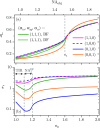Quantitative Measurement of the Optical Cross Sections of Single Nano-objects by Correlative Transmission and Scattering Microspectroscopy
- PMID: 32064304
- PMCID: PMC7011706
- DOI: 10.1021/acsphotonics.9b00727
Quantitative Measurement of the Optical Cross Sections of Single Nano-objects by Correlative Transmission and Scattering Microspectroscopy
Abstract
The scattering and absorption of light by nano-objects is a key physical property exploited in many applications, including biosensing and photovoltaics. Yet, its quantification at the single object level is challenging and often requires expensive and complicated techniques. We report a method based on a commercial transmission microscope to measure the optical scattering and absorption cross sections of individual nano-objects. The method applies to microspectroscopy and wide-field image analysis, offering fine spectral information and high throughput sample characterization. Accurate cross-section determination requires detailed modeling of the measurement, which we develop, accounting for the geometry of the illumination and detection as well as for the presence of a sample substrate. We demonstrate the method on three model systems (gold spheres, gold rods, and polystyrene spheres), which include metallic and dielectric particles, spherical and elongated, placed in a homogeneous medium or on a dielectric substrate. Furthermore, by comparing the measured cross sections with numerical simulations, we are able to determine structural parameters of the studied system, such as the particle diameter and aspect ratio. Our method therefore holds the potential to complement electron microscopy as a simpler and cost-effective tool for structural characterization of single nano-objects.
Copyright © 2019 American Chemical Society.
Conflict of interest statement
The authors declare no competing financial interest.
Figures

 , is computed in the electrostatic approximation
for an elongated NanO placed on a glass/air interface (n1 = 1.52, n2 = 1.00) oriented
as in the enlarged image. The image on the bottom left is an example
of BF transmission with the NanO appearing dark on a bright background.
The image on the bottom right is an example of DF contrast, with the
NanO appearing bright on a dark background. The plot in the bottom
middle exemplifies a cross-section spectrum obtained from the BF and
DF images.
, is computed in the electrostatic approximation
for an elongated NanO placed on a glass/air interface (n1 = 1.52, n2 = 1.00) oriented
as in the enlarged image. The image on the bottom left is an example
of BF transmission with the NanO appearing dark on a bright background.
The image on the bottom right is an example of DF contrast, with the
NanO appearing bright on a dark background. The plot in the bottom
middle exemplifies a cross-section spectrum obtained from the BF and
DF images.
 and no TIR for
and no TIR for  . The collection angle, θobj =
108° has been kept fixed, resulting in a variable NAobj ≡ n2 sin θobj.
. The collection angle, θobj =
108° has been kept fixed, resulting in a variable NAobj ≡ n2 sin θobj.


References
-
- Bohren C. F.; Huffman D. R.. Absorption and Scattering of Light by Small Particles; Wiley-VCH Verlag, 1998.
LinkOut - more resources
Full Text Sources
